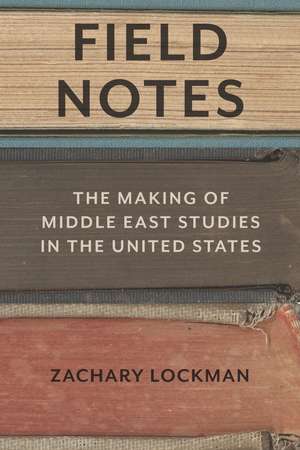Field Notes: The Making of Middle East Studies in the United States
Autor Zachary Lockmanen Limba Engleză Hardback – 29 mar 2016
This book explores the decision-making processes and visions of knowledge production at the foundations, the Social Science Research Council, and others charged with guiding the intellectual and institutional development of Middle East studies. Ultimately, Field Notes uncovers how area studies as an academic field was actually built—a process replete with contention, anxiety, dead ends, and consequences both unanticipated and unintended.
| Toate formatele și edițiile | Preț | Express |
|---|---|---|
| Paperback (1) | 213.10 lei 3-5 săpt. | |
| Stanford University Press – 29 mar 2016 | 213.10 lei 3-5 săpt. | |
| Hardback (1) | 725.73 lei 6-8 săpt. | |
| Stanford University Press – 29 mar 2016 | 725.73 lei 6-8 săpt. |
Preț: 725.73 lei
Preț vechi: 942.50 lei
-23% Nou
138.87€ • 145.36$ • 115.58£
Carte tipărită la comandă
Livrare economică 31 martie-14 aprilie
Specificații
ISBN-10: 0804798052
Pagini: 376
Dimensiuni: 152 x 229 x 25 mm
Greutate: 0.61 kg
Editura: Stanford University Press
Colecția Stanford University Press
Recenzii
Notă biografică
Cuprins
The Preface explains what this book is about, its main focus and sources, some of its key arguments, and the scholarly literatures it seeks to engage with. Unlike the author's earlier book Contending Visions of the Middle East, this book is based on the archives of foundations, academic organizations and universities, and it explores how area studies ¿ and especially Middle East studies ¿ were conceived and launched as new academic fields and how they evolved in the decades that followed. The approach is in keeping with a recent scholarly trend that "follows the money" as a way to elucidate how academic disciplines and fields, and forms of knowledge, have been shaped by extra-academic influences, including the patronage of the big foundations. The Preface briefly discusses some work on area studies as a way of clarifying what this book seeks to do, and why.
This chapter discusses the rise of the Carnegie and Rockfeller philanthropic foundations before the First World War as well as of the establishment of the American Council of Learned Societies and the Social Science Research Council in the 1920s, and explores how, from the later 1920s through the 1930s, foundation funding channeled directly to scholars and universities as well as through the ACLS fostered the development of new networks and sites that fostered the expansion of cross-disciplinary scholarship and training (including language training) focused on specific world regions (rather than along conventional disciplinary lines), especially non-Western regions and their languages. These developments provided experience and models that would be drawn on during and after the Second World War to produce what would come to be called area studies.
This chapter shows how, during the Second World War, the idea of producing interdisciplinary knowledge that was focused on geographic regions and would be useful to government and the military was fostered at a range of new entities and sites, including the Office of Strategic Services, the Ethnogeographic Board and the Army Specialized Training Program, through which thousands of recruits received training in foreign languages and cultures on college and university campuses. Fueled by the conviction that after the war Americans would need knowledge about the world commensurate with the country's new status as a global power, these developments crystallized into a growing sentiment that area studies must become a permanent component of postwar higher education, accompanied by efforts to define what this new field should be.
Even before the end of WWII, the Rockefeller and Carnegie foundations, working closely with the SSRC, began planning to fund a network of university-based area studies centers to produce a new kind of interdisciplinary knowledge and train graduate students accordingly. Large-scale foundation funding resulted in new institutions and practices and by the late 1940s area studies was up and running as a new academic field. Though it was certainly inflected by Cold War concerns and priorities, this chapter argues that its development and content cannot be reduced to them. Another relevant context was the rapid expansion of higher education in the United States that began after the war, and proliferation of new modes of university-based research and training. The rise of area studies was accompanied by considerable contention over its purposes and goals, and by SSRC academics' (ultimately unsuccessful) efforts to elaborate its theory and methodology.
This chapter explores the establishment of the first purportedly interdisciplinary Middle East studies in the United States, at Princeton in 1947, with Carnegie and Rockfeller funding, and reconstructs the vicissitudes of that program into the 1950s. It then investigates the efforts of the American Council of Learned Societies to promote its vision of Middle East studies, with an emphasis on undergraduate education and language instruction, and why that vision ultimately lost out to the Social Science Research Council's vision focusing on social-science research and on graduate training.
This chapter explores the SSRC's engagement with Middle East studies in the first half of the 1950s, mainly through the vehicle of a new SSRC Committee on the Near and Middle East charged with leading the field's intellectual and institutional development. Constituted in 1951, this committee proved unable to formulate an effective research program or to secure funding from the Ford Foundation, which became by far the biggest patron of area studies in the 1950s.
This chapter focuses on the decade from the mid-1950s to the mid-1960s, during which, thanks to a massive influx of foundation and (from 1958) federal funding, Middle East studies got off the ground. It explores this development through the work of the reconstituted SSRC committee for the field, which accomplished a great deal in terms of establishing the field's infrastructure (language-training programs, research fellowship programs, library and bibliographic resources, etc.) but was much less successful at its task of elaborating a research agenda rooted in some coherent paradigm of area studies or Middle East studies.
By the early/mid 1960s, the rapid growth of Middle East studies created the material basis for a national professional organization for the field, and this chapters explores the efforts to achieve that. It begins by reconstructing the rise and fall of the American Association for Middle East Studies, which played an active role for some years but then disappeared, apparently because of its Zionist connections. It then narrates the foundation of the Middle East Studies Association in 1966, that association's early history, contention within it concerning politics, diversity and democracy, and how scholars and institutions in this field came to be subjected to politically motivated attacks by outside groups.
This chapter traces the trajectory of the SSRC-ACLS Joint Committee on the Near and Middle East form the late 1960s to the 1980s, focusing on its ongoing (but largely unsuccessful) struggle to formulate a coherent research agenda for the field, its members' anxieties about what they perceived as the inferiority and backwardness of their field in relation to disciplines like political science, and their pessimism about the field's prospects. It ends on the cusp of the changes of the 1980s that transformed many humanities fields, including area studies.
The Epilogue opens by discussing the SSRC's decision in 1996 to dissolve its regional committees and put in place a new structure for its international work. Summing up a key thrust of the book, it argues that the 1980s proved a turning point for Middle East studies because the intellectual, social and cultural shifts of that period rendered moot the longstanding quest for a paradigm that would inform the field intellectually. Thus it came to be recognized that this field had an essentially institutional and social basis, rather than an intellectual one. The Epilogue also engages with the widespread scholarly perspective that depicts area studies as essentially a product of the Cold War as well as with a number of other takes on the history and import of area studies, and discusses the question of what impact efforts to produce "policy-relevant" knowledge actually had on policymakers.













